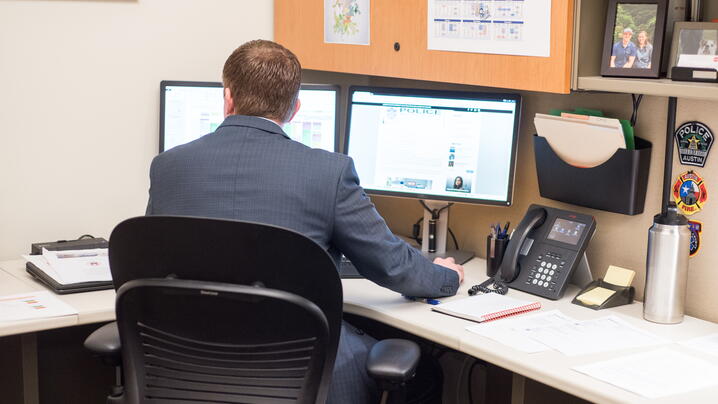
Former ICMA executive director, William H. Hansell, once said that productivity improvement is a perennial challenge for managers – particularly in local government, where services are highly labor-intensive. Innovative managers continuously seek to improve productivity, to help employees throughout the organization “work smarter, not harder.”
The question is do you know how productive your staff is? Are they working smarter, not harder? Or maybe not hard at all? Here are some interesting statistics on productivity in the workplace:
- The highest-performing 10% of workers tend to work for 52 minutes followed by 17-minute breaks. [Source: The Atlantic]
- 23.4% of workers cited socializing with co-workers as the second leading office distraction. [Source: TrendHunter]
- The average worker spends 1.8 hours each day searching for and gathering information. [Source: McKinsey]
If you want an organization where your staff is indeed working smarter, not harder – it may take productivity improvement techniques to get you there. The first thing to do is identify productivity improvement steps so you can implement a productivity program in the workplace. Here are eight:
Step 1: Identify areas that are “ripe” for productivity improvement.
While you may eventually want your program to consider a large number of functions in your jurisdiction, it is best to begin by isolating a specific problem in a specific area. Start with the following starting points for problem identification.
- Functions continually faced with large backlogs of work or slipping deadlines
- Operations where visible problems have already been hinted at (citizen complaints, high employee turnover)
- Operations which appear to be using unusually large percentage of resources
- Operations where large numbers of employees perform essentially repetitive tasks (payoffs will be especially evident here due to the effect of multiplying any increase by the number of employees)
- Availability of new techniques or technology already proven practical elsewhere
- Receptivity of managers and supervisors to new ideas couples with an ability to follow through
Step 2: Locate models in other jurisdictions.
Many communities have already implemented productivity improvement programs. Frequently, the reports of these programs are readily accessible.
Step 3: Define the roles of those who will be involved in planning and implementing the program.
Once a specific area or service has been selected as a productivity target, it will be necessary to determine what staff will be needed and exactly what the responsibilities of each will be. An important consideration is just where the productivity staff will be located in the organization. Will the program be the responsibility of a separate “staff” office or of the “line” service agency?
Arguments can be made for either arrangement, but the ultimate decision rests with specific situations and perhaps personalities.
Step 4: Set realistic goals and objectives.
Any productivity program must first be concerned with what government should or should not be doing to meet the needs of its citizens. Unfortunately, many citizens are uninformed about what government does, or is supposed to do. These are the individuals who only become involved in the system when there is an apparent breakdown of a crucial service.
It is important to attempt to quantify what is being aimed for. Frequently, it helps to think in terms of “desired outcomes.” For example, a desired outcome might be stated: “At the end of a six months period, Fire Department X will have cut its response time by an average of two minutes per call.” A yardstick has then been established by which to measure the success of a productivity improvement program.
Step 5: Choose among alternatives.
Productivity improvement can often be achieved by way of several approaches. In planning a program it is important to determine: Which of the alternative approaches can provide the jurisdiction with the most favorable outcomes? Which is the most realistic for us? Will the problem best be solved through the use of labor-management-cooperation, technological and operational innovation, or worker motivation and supervisory techniques?
Step 6: Anticipate problems.
It is important to remember that you are a pioneer, and others will be watching to see what you do. Early successes will make subsequently productivity efforts easier. But the development of any new project invariably encounters problems. The probability of failure can be reduced to the extent that problems can be anticipated and solutions created. Several problems to anticipate include: lack of agreement, misconceptions, and politics.
Step 7: Implement the program.
The best-conceived productivity program will be useless unless implemented carefully and strategically. Most successful productivity programs across the country have followed guidelines which include staged implementation, low profile, monitoring, and external assistance.
Step 8: Evaluate the program.
Objective evaluation is important in any improvement program, but more so in productivity programs because measurement is almost invariably identified with productivity. No matter how “successful” managers claim a program is, taxpayers and their elected officials who fund such programs are likely to reserve judgment until specific objective data indicate substantial achievements. At least two considerations as to evaluative feedback are important – types of feedback (i.e.; client satisfaction, cost savings, observer evaluation) and ways of reporting it (i.e.; quarterly and annual reports, release of data, use of data).
This content has been extracted from the ICMA publication, Productivity Improvement Techniques: Creative Approaches for Local Government, written by Marc Holzer, Ellen Doree Rosen, and Constance Zalk.
New, Reduced Membership Dues
A new, reduced dues rate is available for CAOs/ACAOs, along with additional discounts for those in smaller communities, has been implemented. Learn more and be sure to join or renew today!
